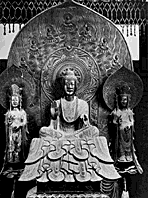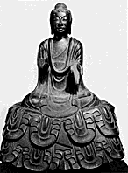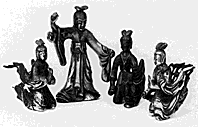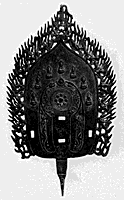
|
Asuka period carving images |
|

Syaka triad at Horyuji
|
|
OTHER BUDDHIST IMAGES OF THE ASUKA PERIOD
In art history, the term "Asuka Period" denotes the time between the introduction of Buddhism and approximately the middle of the 7th century, while the latter half of the 7th century is denoted by the term "Hakuho Period." Buddhist images of the Asuka Period, so defined, were made primarily by craftsmen of of continental immigrant stock, and the period's mainstream works were the Tori-shiki Buddhistimages such as the Asuka Daibutsu, the Shaka triad (produced for the Horyuji kondo in 623 by Kura-tukuri-no-Tori),the Guze Kannon in the Horyuji Yumedono, etc."Tori-shiki" Buddhist images were influenced by the Buddhist art of the Northern Wei Period in China and exhibit such characteristics as a marked frontality, almond-shaped eyes, upward-turned crescent-shaped lips, and symmetrically arranged folds in the clothing. Besides the Tori-shiki images, there also remain from the Asuka Period such images as the Kudara Kannon at the Horyuji and the "bodhisattva half-inclined in meditation" (bosatsu hankazo) at the Cyuguji(part of the Horyuji)
|

shijuhatai-butsu
("The Forty-eight Buddhist Images")
These are an assemblage of 59 miniature giltbronze Buddhist sculptures, produced at various times from the Asuka through the Tempyo Periods They were at one time in the possession of the Horyuji Among them are several which had been transferred there from the Tachibanadera in the 11th century They are presently housed in the Tokyo National Museum. The number "forty-eight," while inaccurate as a name for the present collection.seems to have been chosen as a reflection of the "48 vows of Amida"
|
|

BRONZE FIGURES OF LADY MAYA AND HEAVENLY ATTENDANTS (TENNIN)
( part of the Shijuhattai-butsu)
first half of 7th century
This is an ensemble representing the scene of the birth of Shakyamuni (Japanese pronunciation: Shaka) from beneath the arm of his mother, the Lady Maya. Since the earliest days of the Buddhist faith in India, objects of Buddhist reverence in various parts of Asia have included, in addition to images representing the person of the historical Shakyamuni in idealized form. paintings and sculptures recalling the vicissitudes of the Buddha's life as given in the traditional accounts (butsuden). In Japan, however, the latter type of Buddhist art is unusual.
|
|

BRONZE NIMBUS (KOHAI)
(One of the Shijuhattai-butsu)
This is the halo for a Shaka image and was produced by O En son (Chinese pronunciation: Wang Yansun), perhaps a continental immigrant, in a year which, as designated in the Chinese sixty-year cycle by the characters kolin, could represent in this case either the year594 or the year 654. It is a so-called ikkosanzon-shiki halo, designed to enfold both a central image and attendant Boddhisativas flanking it on either side. Nimbuses which, Iike this one, have attached to them small Buddhas and heavenly attendants (tennin) are very often used with Buddhist images that, Iike the Asuka Daibutsu or the Shaka Nyorai in the Horyuji Kondo. draw on tradition of the Northern Wei.
|
|Asuka Period
|THE ASUKA PALACES
|ASUKA STONES
|ASUKA KOFUN|
|TAKAMATSUZUKA KOFUN
|THE ASUKA TEMPLES
|ASUKA AND THE MAN'YOSHU|
Copyright (c) 1995 ASUKA HISTORICAL MUSEUM All Rights Reserved.
Any request to kakiya@lint.ne.jp
Authoring: Yasuhito Kakiya
|